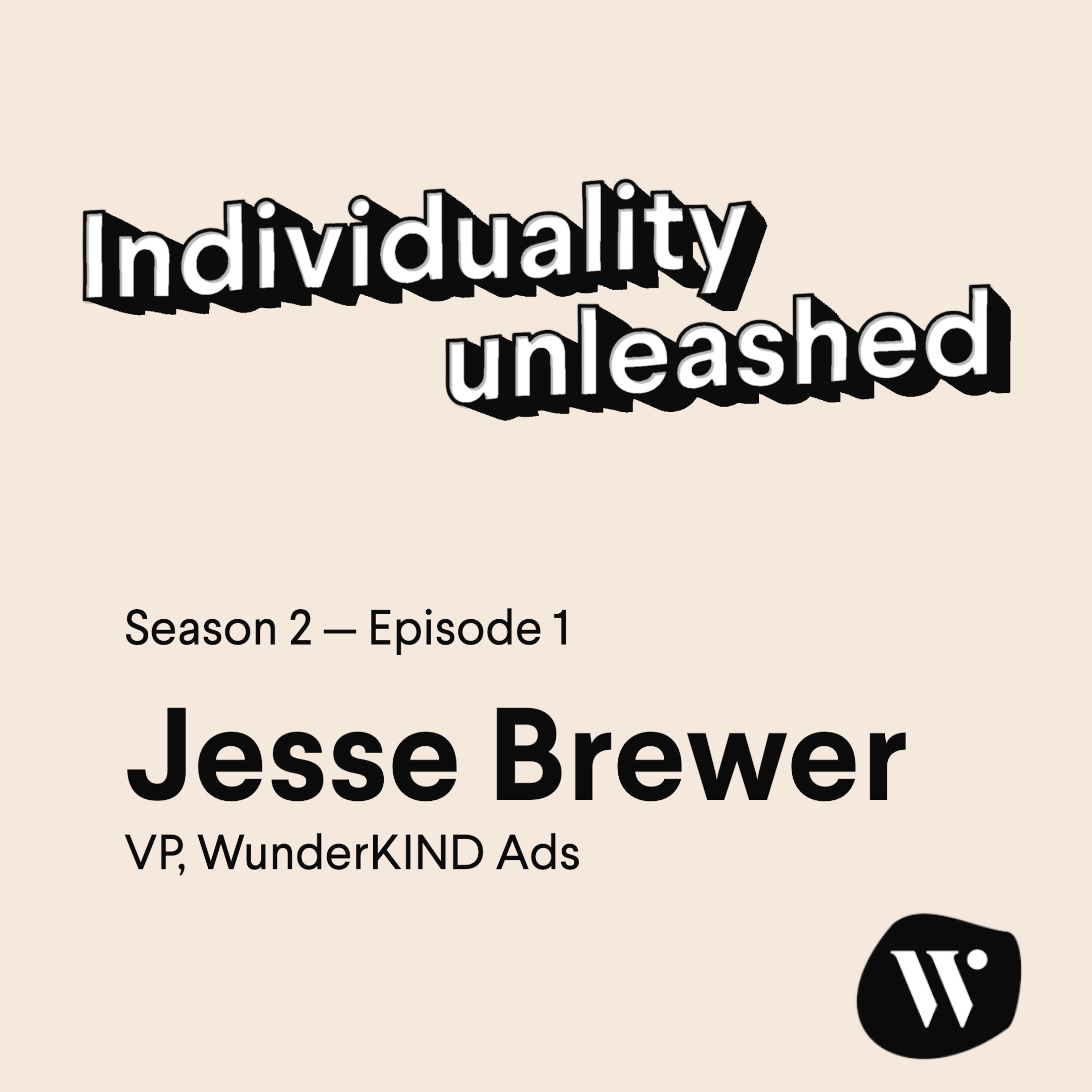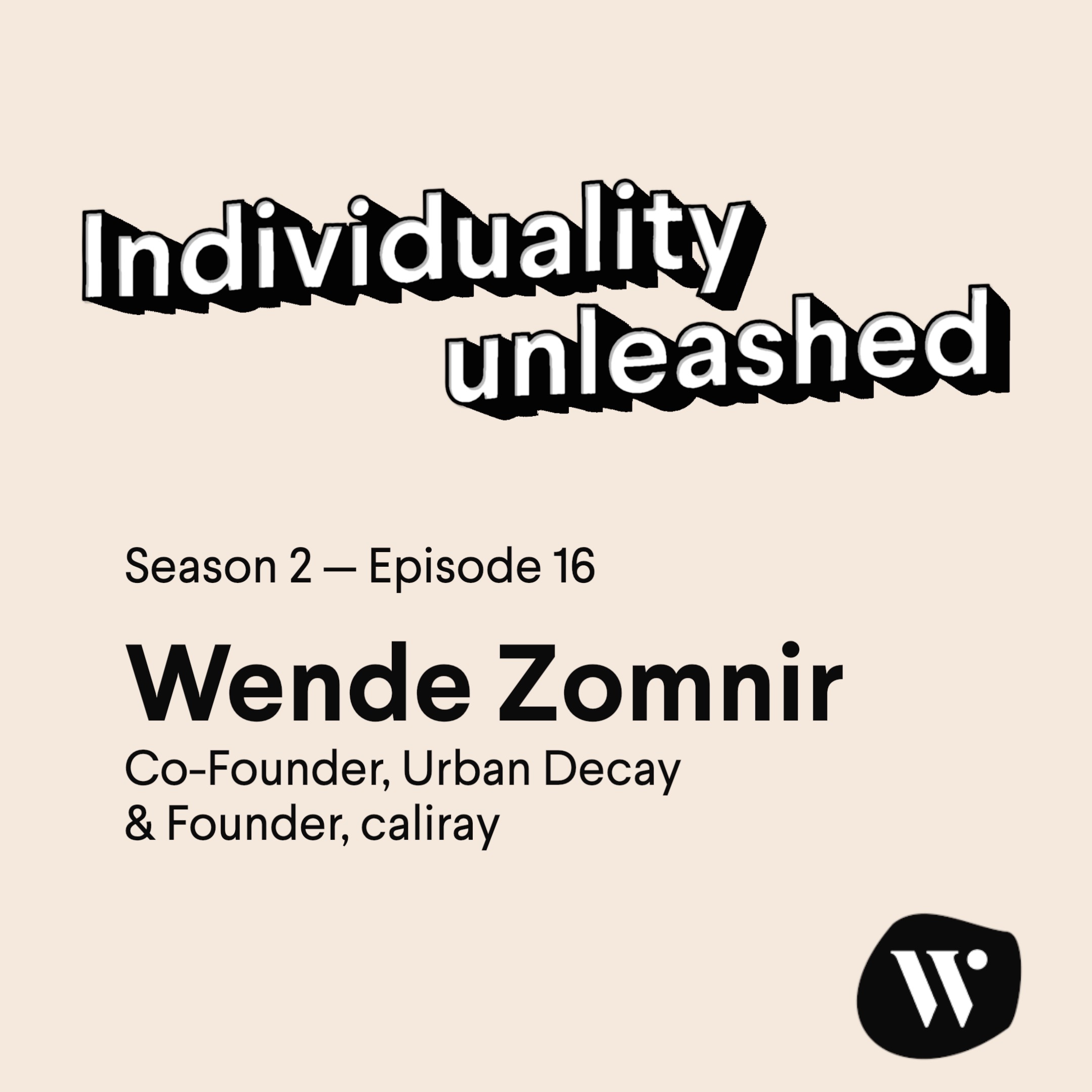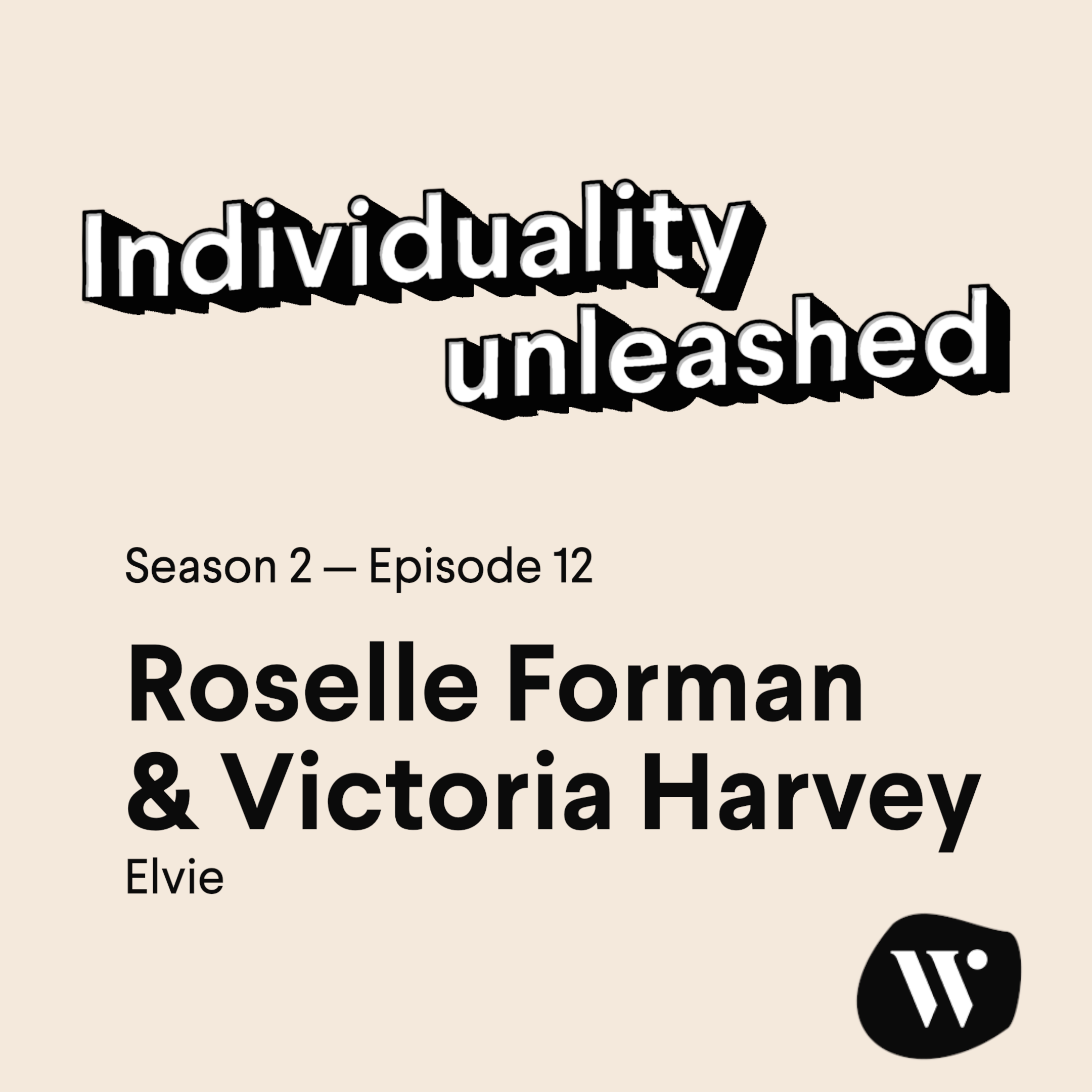WunderKIND Ads
- 0.5
- 1
- 1.25
- 1.5
- 1.75
- 2
Richard Jones: Today on Individuality Unleashed, I'm pleased to be joined by Jesse Brewer, VP of Wunderkind Ads. How you doing, Jesse?
Jesse Brewer: Good. Good, good. Great to be here.
Richard Jones: Well, today we'll be discussing advertising on the web and the evolution of online ad experiences and how doing what is right for the user also benefits advertisers and publishers. Now, we really want to get into the details about how putting the user first can bring better campaign performances for advertisers and more revenue overall for publishers.
Jesse Brewer: Yeah. So let's start at the beginning. So like, in any advertising medium, there's a need for standardization. So you see it on television with 30 second spots and 15 second spots, and then on the web with banners. So in the mid'90s, like 300 x 250s and 728 by 90 banners, which are still around on publisher pages. What's amazing is that when they first came out, 44% click through rate, that was the first banner. So wildly-
Richard Jones: Imagine, imagine.
Jesse Brewer: Right. But what happens is that standardization is important. You need it. Publishers need it, advertisers need it. There needs to be one currency between them, right? That's what supports advertising is that standardized currency between them. So you need the standardization. But what happened was it was so wildly effective at first, it grew so fast. And eventually, users just saw so many banners. Advertisers were pumping money into it. Publishers were trying to make that money. Banners proliferated everywhere. Users saw so many banners online that they started to become ineffective. So by 1998, so soon after the first banner actually was on the web, the term banner blindness was coined, which is essentially a form of selective attention where web visitors ignore information presented in banners.
Richard Jones: And I've become extremely effective at doing that now. Lot of practice since 1998.
Jesse Brewer: Right, right. So with that decrease in attention, advertisers obviously are not as interested. If they're not getting their user's attention, they don't want to pay for it anymore. And publishers then are not able to command those high CPMs and command as much budget. So what happens is there's more and more of these banners, they become less and less effective, and there's just this race to the bottom. Let's pump out as many ad placements as possible so we can try and hold onto some of this revenue. And what everyone's forgetting about is the user, right?
Richard Jones: Yeah. It's extremely annoying to have that many ads fired at you, disruptive experience. We all know it. We've all been on publisher sites and not had an optimal experience. Not every publisher, but we've experienced it.
Jesse Brewer: Right. And the thing is too, they have to do it. They need to support themselves. And I think everyone understands that. We want to support quality journalism. We understand the information economy where users want information for free. They're willing to see ads for it, but they're not willing to see this many ads for it.
Richard Jones: So what's the solution? What's that middle ground between the publishers being able to support themselves and a solid user experience?
Jesse Brewer: So I think after the initial issue with banner blindness, what a lot of publishers and tech vendors tried to do was move into more high impact experiences, which that's the next evolution. But there was a little bit of a misstep because a lot of these solutions, like these roadblocks and page grabbers and takeovers that came out, even in their naming, they imply that they block a user from their content. It seems obvious, but it really was a bit of a misstep where it's like you can't just go from these tons of tiny banners to now huge, massive banners and expect it to be better for the user. So again, there is a misstep where everyone's forgetting about the user. They're not putting the user first. They just happen to be part of the equation. So yeah, that was a bit of a misstep. And so when ad blocking came out, so this is 2015 ad blocking, I think it was actually 2009 when it came out, but 2015 was when it really started to take off.
Richard Jones: Really took off.
Jesse Brewer: So at that point, the cause when we started asking users, " Why are you installing ad blockers?" Why don't you want to hear from us anymore, essentially is what we're saying. And they said, over 60% said, " It's because these ads are too intrusive and too annoying." So obviously, we didn't get it right with going from those standard banners to these larger format experiences. We're forgetting the user, and it's still kind of biting us in the ass a little bit.
Richard Jones: The pendulum swung too far.
Jesse Brewer: Yeah, exactly. And even now, there have been efforts in the industry and we support these efforts, and I do think they're really important, like The Coalition for Better Ads, for example, 2017, it came out. And super important and just that concept, we stand by it. But our question is, has it gone far enough? Is it really positively impacting user experience enough with some of these ad formats? And what we've seen in our research, even as recently as a couple months ago where we talked to 1, 000 different avid online US readers, they said still ad experience is not quite where it needs to be. And in fact, it's gotten a little worse over the past few years.
Richard Jones: Right. So tell us a little bit about Wunderkind Ads and why kind ads.
Jesse Brewer: Yeah. For sure. So I think the evolution of our product mean, initially we spoke about it, we referred to them as post content ads because it was very new. It was a new thing in the market, sadly to say the focus on the user and the focus on the publisher content, being able to get to the user was so new that we had to give it a really literal name. So we refer to it as post content ads. But really, that's such a literal name for it. The value is in it being kind. It is kind to the user, and that's part of why we have changed that name. And we are moving forward with a slight rebrand because we do want to encapsulate that value of just being kind to the user. Like I talked about before, it's just been forgotten about. In every iteration of these new banners, new formats, the user's always last. So we want to bring forth kind ads, which we strongly feel are a user first ad experience.
Richard Jones: And when we talk about post content ads, for our listeners, provide a little bit more context about why is that a better user experience, how the ads loaded. Give us a bit more context.
Jesse Brewer: Yeah. And to give you a quick look under the hood, the way we determine what is a post content ads. So we have really unrivaled visibility into how users interact with websites, right? Because we're not just an ads company. We have our whole onsite platform, our email platform, our text platform. So we have this wild amount of visibility into how users interact with the site. We're essentially running four billion AB test impressions every month to understand how users interact with websites and specifically publisher websites, and when are they disengaged from content and actually willing to engage with something else, willing to receive an alternative message from someone like a brand.
Richard Jones: What's that point in that user experience where they're not being interrupted, where the ad actually is going to be a positive experience?
Jesse Brewer: For sure. And what we've seen is that specifically that moment of disengagement. So things like when a user scrolls and reads, their full article gets significantly below the fold and then scrolls back to the top of the page. Essentially when someone's got their article, they're scrolling back to the top to look for the navigation bar, look for something else, potentially even leave the site, a lot of users do that. And that's when we'll create this real estate in front of them to reach them in between articles saying, " Hey, let's just give you a choice. We know you're kind of disengaged. You're looking for something else. How about we allow Ford to place their ad in front of you?" Other examples are when someone's scrolling in line on an article, we're never going to place an ad right in the middle as they're reading. What we'll do is we'll see maybe that person is changing tabs, they're taking a break from that information. If they change tabs, if and only if they return to that tab, when they return, we'll have split that article exactly where they had left it and have a nice, beautiful, large format ad placement ready for them. Because we knew they came to that site, they got what they initially wanted and took a break. And now when they're returning, we're saying, " Hey, dive back into your article or check out this really, really nice tailored brand message."
Richard Jones: So completely get why it's a kind user experience for those that are actually on the publisher's sites, consuming the content. But tell me a little about what do the advertisers and the publishers get out of it.
Jesse Brewer: Right. For sure. And I think brings up a good point because in order for advertising to work not just about the user, you got to support the advertiser, you got to support the publisher, got to bring the advertiser campaign performance, publishers actual ad revenue. But what we've seen and what's really been nice for us, what takes this from a feel good story to an actual practical application in the advertising world is that it does drive better performance for advertisers. So think of it this way, what we're doing is simply acknowledging that users want publisher content. So we give it to them first. And only after that are we asking them for something in return, which is engagement with the brand. We are and shamelessly creating large format ad experiences, but only at the inflection point when users are actually done with content and ready to move on to something else. So what that does, the advertisers get 4x the screen real estate, which is amazing, if you were doing that and not respecting their experience, not good. But if you're doing it with respect for their experience, it's amazing. So 4x the screen real estate, but only at that inflection point where they're thinking about doing something else besides consuming publisher content. And that's where you get not just the really high viewability, it's great, 80% viewability is great, but honestly it's easy to do. It's more about the attention you're driving. So a 25% lift in actual attention.
Richard Jones: That's huge.
Jesse Brewer: And then even as you go further down the funnel, 2. 5x industry average CTRs, which is amazing. And CTRs, yes, I will say, and I hope I don't get in trouble with this, an outdated metric, but still important. It's only important if those clicks are qualified clicks.
Richard Jones: Right.
Jesse Brewer: So that's where we get further down to the funnel where it's a 30% lift and qualified traffic to the site. So not just accidental clicks because someone's trying to get to their content. It's more someone that's wants to learn about the brand, wants to engage, wants to go to your page and learn more and even buy things, sign up for email lists, sign up for text messages. So that's where advertisers win with that positive user experience. They're getting the opportunity to reach people in a way that implies the user is interested and implies they want to learn more, and implies they want to hear more from that brand. So it's a real great audience development tool that does everything from the upper funnel all the way down to that more qualified visitation to this site and mid and lower funnel metrics.
Richard Jones: That's amazing. So it seems like the advertisers are essentially getting a full funnel ad solution. They cannot only get their users' attention, but also drive really meaningful engagement with the brand and large volumes of qualified traffic to their site. So you shared quite a lot of metrics about what it means for advertisers, but have you got any metrics about what it means for publishers?
Jesse Brewer: Yep, definitely. So by offering that more full funnel solution for advertisers, publishers can really reap those rewards because advertisers are reasonable. If it works, they're going to spend more and they're going to spend more frequently. In terms of metrics for publishers, what they typically see, a 10 to $15 CPM. So real industry leading CPMs that are coming from web banners. Incremental demand, so usually a five to 10% lift in revenue. And typically, we're a top five revenue partner. And what's really important about all of that, that's not short term where they flip it on and get a little extra revenue, but at the same time are ruining their readership. This is where it all comes back to the user first approach. So if they're able to get that revenue by putting these really large format respectful user experiences on their site, what that does, they can make more money without ruining the relationship with their readership and their users. Because otherwise, you might be able to do this short term, but slowly, users are going to stop coming back to your site if there's a bad experience. So really what we're doing is that, yeah, it's a win for users and that's what we're committed to and that's our ethos. And then it just happens to also work out quite well for advertisers and publishers as well.
Richard Jones: I know weather.com is one of the publishers that we actually work with. So let's take a minute and listen to their view of working with Wunderkind ads.
Speaker 3: It's a daily habit. It has a tremendous mission of keeping people safe and having that most accurate information and alerts on your phone to let you know that, hey, you might need to evacuate. Really essential. The brand mission is really helping users get the knowledge that they need in whatever particular weather situation, accurately and quickly. Our second mission is to use that data that we collect on the weather and provide insights to our advertisers and clients. The Wunderkind partnerships has to be very good for both sides. It's been a strong partner for us in terms of working together. I also think that what we like about Wunderkind is the quality of advertising. I think they're very high quality advertisers and ones that feel really good to be associated with. Our team's biggest goals is to drive revenues, but also to really help drive revenues in a way that's good for user experience. We always load our content first, giving the users the information they need for the day or the week. We actually load ads afterwards. We want an experience where the ads come quickly after the content, so it looks like a very seamless experience. Really selecting the right ads and the right type of ads that would be good for both advertisers and the site and our users, that is something that has been helpful for us. We track user experience very carefully and we see what are some of the responses they have to some of the advertising on our site. We actually take a very conservative approach, and we feel that a type of advertising's not right and aligned with our brand, we'd rather forego the revenues and really take that off the type of advertising. And so I would say minority that gets the ads, it's really at the appropriate instances. There are very few things you actually have to check every day, and this is one of those. And it's really phenomenal to work for a company that has a mission that really keeps users safe. It's additional impact beyond just driving revenues.
Richard Jones: So I think it's probably also interesting for our audience because many people that will listen to this show will know Wunderkind as a new performance marketing channel that drives revenue for folks. So here we are talking about a new kind user experience for ads, Wunderkind Ads, why are we doing ads and why are we doing performance marketing channel? What's the connection here?
Jesse Brewer: Right. So our performance marketing channel's super successful. That was the inception of the company and what the company's been largely built around. But what we want to do with kind ads is actually get those users to the site in the first place, drive that large volume of qualified users to your page so that then our performance marketing engine can be powered. We want to feed those people in so that we can then identify them, then reach them over other channels as well.
Richard Jones: So if you think about that, the rationale as I like to segment things, I talk about our performance marketing engine as revenue as a service. We'll talk to e- commerce brands, we'll look at their operations on their website, and we'll figure out delivering a guaranteed revenue uplift, for how we can use identity to figure out the right messages to send to people on the right channels that drive revenue. And we are experts at actually doing that. But of course, it does require people coming to those own channels, coming to those sites. So the Wunderkind ads are a way of actually providing traffic to the brand that we can then better convert. So we have that kind of whole funnel experience.
Jesse Brewer: Exactly. And I think that is exactly it, is it's traffic and it's qualified traffic. And I think that's the important distinction. And that's why sometimes in the past just saying traffic has had that negative connotation. We're saying qualified traffic.
Richard Jones: Right, right.
Jesse Brewer: But I think a great way for us to pose it is more just like what is qualified traffic? That's an audience. So kind ads are really an audience as a service, and that's where we fit into that larger equation. We're going to feed that performance marketing engine with a qualified audience.
Richard Jones: So for those that don't know, Wunderkind is able to deliver an audience of service to engage with a brand's prospective audience across premium publishers to drive qualified traffic back through to their own channels, and then use the Wunderkind performance marketing engine to identify and deliver revenue from that traffic in a better way than they can on their own. So really love what we're doing around this.
Jesse Brewer: Yep. The full story, all of those channels working together, it's great that they can all work in a silo and they're effective, but using all of them together is really where brands get ahead, and that's where we've seen the greatest success. So really excited to see more brands adopt that because I think it is where the industry is going, especially with the deprecation of the cookie. Brands need to build that audience, they can't just buy it somewhere else.
Richard Jones: And we've seen falling user numbers, time on site, on platforms like Facebook and others. It's great that there's now this additional capability through Wunderkind to deliver these great brand experiences, great user experiences across premium publisher network globally. So we've launched in the UK, we're starting spread into different markets. So I love the success that you're having, Jesse.
Jesse Brewer: Thank you so much. Appreciate that.
Richard Jones: So Jesse, where can I see examples of these creatives, these ads?
Jesse Brewer: Yeah, absolutely. And I think you could go to really one of many top tier publishers on the web if you want to see them, or more immediately, you could go to our lookbook where you can check out the experiences themselves, so how the placements work, see in real time, how they respect user experience. And you can see the different functionalities that we can package into them. Just based on advertiser KPIs, if someone wants to drive foot traffic to their dealership, we can place a tap to map creative. So you can see that functionality in the lookbook. Or if you want to show someone when a new show is launching or when a movie's premiering, you can see countdown clock creatives. So really, really good resource to see not just the user first approach, but also the functionalities that advertisers can package into that to drive their KPIs for campaign performance. So I can really talk for hours, sadly, about full funnel performance for advertisers, but I think it'd be more effective just to hear from some of our ad buyers themselves.
Speaker 4: When it's something that a user can't click out of or something that takes their space for over 30 seconds, that is a terrible experience, and one that is bound to leave an impression, negatively for the clients, for sure. And also the consumers against that client.
Speaker 5: Does the client look for a partner that can do more than just upper funnel and also middle and lower funnel?
Speaker 6: Yeah. It's super hard to find a partner that can do all of that. And so sometimes they don't care about viewability, they don't care about clicks. But if they don't see the ROAS, then they're going to cut the partner. Wunderkind has been able to do all of that, and so they're in a mid- funnel campaign, which high impact partners usually aren't in.
Speaker 7: Definitely, I think the biggest difference that you guys have with your product is the shoppable element, with the high impact units that you have. It's highly engaging. It takes up a considerable amount of the screen after the user has engaged with the page sufficiently, but then it also has that shoppable element where it gives the user the ability to expand whatever product they're interested in, get a bit more information about whatever they are looking for before going to site.
Richard Jones: So Jesse, thank you very much for coming on the show and telling us about Wunderkind Ads. Now, if you'd like to know more about Wunderkind Ads and what it can do for you, whether you're an advertiser or a publisher, then click on the link below, or in the description, and we will tell you more. My name is Richard Jones. This has been Individuality Unleashed. See you soon.
DESCRIPTION
Click here to learn more about WunderKIND Ads.
Follow Wunderkind:
YouTube: https://www.youtube.com/@bewunderkind
Instagram: https://www.instagram.com/bewunderkind
Facebook: https://www.facebook.com/BeWunderkind/
Twitter: https://twitter.com/wunderkind
More from Wunderkind: https://www.wunderkind.co/resources/
Wunderkind is a performance marketing channel that delivers one-to-one messages across email and text at an unmatched scale.







